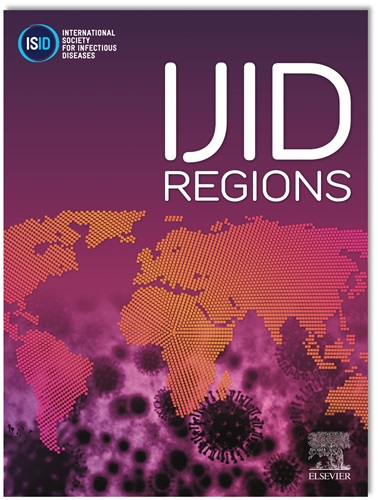含有多种毒素变异和定植因子的产肠毒素大肠杆菌的共感染和临床影响:2017-2022。
IF 4.8
2区 医学
Q1 INFECTIOUS DISEASES
引用次数: 0
摘要
目的:肠产毒素大肠杆菌(ETEC)和其他肠道病原体的合并感染加重了腹泻病的严重程度,使诊断和治疗复杂化。本研究探讨了孟加拉国达卡地区ETEC及其合并感染的患病率、临床表现和危险因素。方法:该研究使用达卡医院腹泻病监测系统的数据,涉及2017-2022年的16,276例患者。我们从16276个数据点中确定了1404例ETEC阳性患者,以调查ETEC感染、合并感染和临床结果之间的关系。结果:ETEC感染1404例(8.6%),成人感染最多(56.6%)。ETEC共感染分别与霍乱弧菌(23%)、气单胞菌(14.6%)、轮状病毒(11.8%)、弯曲杆菌(6.5%)和志贺氏菌(1.7%)合并。成人更有可能同时感染ETEC和霍乱弧菌,而5岁以下儿童更有可能同时感染ETEC和轮状病毒。同时感染霍乱弧菌、轮状病毒和沙门氏菌会增加发烧的可能性,而ETEC同时感染霍乱弧菌会增加呕吐、脱水和静脉输液的风险。结论:ETEC和合并感染加重了疾病严重程度,使医疗保健系统负担过重。政策制定者应优先考虑针对ETEC和合并感染的弹性医疗保健战略。本文章由计算机程序翻译,如有差异,请以英文原文为准。
Coinfection and clinical impact of enterotoxigenic Escherichia coli harboring diverse toxin variants and colonization factors: 2017-2022
Objectives
The severity of the diarrhea disease is exacerbated by co-infections that involve Enterotoxigenic Escherichia coli (ETEC) and other enteric pathogens, which complicate the diagnosis and treatment. This study explores the prevalence, clinical manifestations, and risk factors of ETEC and its co-infections in Dhaka, Bangladesh.
Methods
The study used data from the Diarrheal Disease Surveillance System at Dhaka Hospital, involving 16,276 patients from 2017 to 2022. We identified 1404 ETEC-positive patients from the 16,276 data points to investigate the association between ETEC infections, co-infections, and clinical outcomes.
Results
ETEC was identified in 1404 (8.6%) of cases, representing the most common infection among adults (56.6%). ETEC co-infection occurred combined with V. cholerae (23%), Aeromonas (14.6%), rotavirus (11.8%), Campylobacter (6.5%), and Shigella spp. (1.7%), respectively. Adults were more likely to develop co-infections with ETEC and V. cholerae, while children under five were more likely to develop ETEC co-infections with rotavirus. Co-infections with V. cholerae, rotavirus, and Salmonella spp. increased the likelihood of fever, while ETEC co-infections with V. cholerae increased risks of vomiting, dehydration, and intravenous fluids.
Conclusions
ETEC and co-infections exacerbate illness severity and overburden healthcare systems. Policymakers should prioritize resilient healthcare strategies for ETEC and co-infections.
求助全文
通过发布文献求助,成功后即可免费获取论文全文。
去求助
来源期刊
CiteScore
18.90
自引率
2.40%
发文量
1020
审稿时长
30 days
期刊介绍:
International Journal of Infectious Diseases (IJID)
Publisher: International Society for Infectious Diseases
Publication Frequency: Monthly
Type: Peer-reviewed, Open Access
Scope:
Publishes original clinical and laboratory-based research.
Reports clinical trials, reviews, and some case reports.
Focuses on epidemiology, clinical diagnosis, treatment, and control of infectious diseases.
Emphasizes diseases common in under-resourced countries.

 求助内容:
求助内容: 应助结果提醒方式:
应助结果提醒方式:


